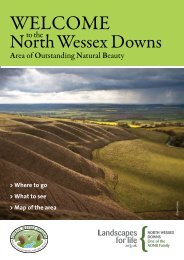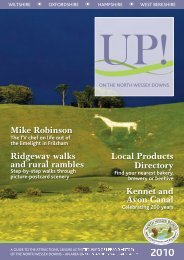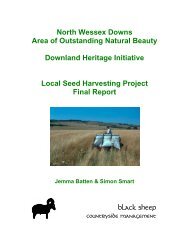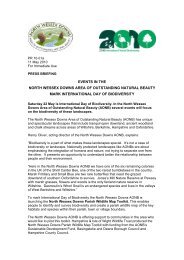UP! - North Wessex Downs Area of Outstanding Natural Beauty
UP! - North Wessex Downs Area of Outstanding Natural Beauty
UP! - North Wessex Downs Area of Outstanding Natural Beauty
Create successful ePaper yourself
Turn your PDF publications into a flip-book with our unique Google optimized e-Paper software.
The <strong>North</strong> <strong>Wessex</strong> <strong>Downs</strong> owesmuch <strong>of</strong> its character to farming –over the years it has enhanced andprotected the area’s landscape.The unassuming exterior <strong>of</strong> afarm near Hungerford, Berkshire,gives nothing away <strong>of</strong> itscelebrated past, and the eventswhich changed British agriculturalprocesses forever, thanks largelyto a man named Jethro Tull.On the A338 about three miles out <strong>of</strong>Hungerford on the way to Salisburyyou’ll see, on the left-hand side <strong>of</strong> theroad, a neat farm sign saying ‘Prosperous HomeFarm’. That’s all it is – a farm sign. There’s nothingabout it that signifies the vital part ProsperousHome Farm has played in the history <strong>of</strong> farming.It was the test bed where one Jethro Tulldeveloped the very first horse-drawn seed drilland the horse hoe. His name is linked with ‘Turnip’Townshend, more formally known as 2nd ViscountCharles Townshend <strong>of</strong> Raynham, Norfolk; ‘Turnip’because he popularised the use <strong>of</strong> root cropsin crop rotations. He, Jethro Tull and a handful<strong>of</strong> other pioneers at that time in the 18th century,revolutionised British agriculture.Today’s Prosperous Home Farm is a delightfulspot, 300 acres <strong>of</strong> rolling Berkshire countryside, thehome to a herd <strong>of</strong> pedigree Guernsey cows, themilk from which is sold <strong>of</strong>f the farm either as milk,unpasteurised blue cheese, yoghurt, crème fraicheor cream. The farm has a stall at several farmers’markets and anyone can call in at the farmyard tomake a purchase. If there is no-one about to takeyour money, an honesty box provides a mute butpersuasive reminder.Prosperous Home Farm is bisected by severalfootpaths. In the autumn walkers have a goodchance <strong>of</strong> seeing a modern seed drill – a directdescendant <strong>of</strong> Jethro Tull’s invention – forgingacross chocolate-brown fields behind a tractor thepower <strong>of</strong> which would have been unimaginable inJethro Tull’s day.In the spring, the legacy <strong>of</strong> this agricultural writer,farmer and barrister is plain to see as rows <strong>of</strong> greenTullingthe landfingers poke through the soil. Before Jethro Tull, cropswere broadcast by hand from shallow baskets. Someseeds or grains remained on the surface, others weretoo close together to allow the efficient eradication<strong>of</strong> weeds. His unique invention, however, buriedevery seed in its proper space and allowed thepassing <strong>of</strong> a horse hoe between the rows.Both the farm and the herd <strong>of</strong> Guernseys aremanaged by Mr Derek Moody for the farm owners,Mr and Mrs Rod Kent. Acting as herdsman to 130-140 cattle (around 85 in-milk cows, the restfollowers) is usually regarded as a full-time job, butworkers into the cream, yoghurt, and crème fraicheon which Prosperous Home Farm has built itsenviable reputation.It is obvious that Mr Kent, the owner, regardshimself as custodian <strong>of</strong> his patch <strong>of</strong> countryside.Thefarmstead is as neat as a new pin and the road thatthreads through the farm is better surfaced andmaintained than any country lane. Hedges, fencesand buildings are ‘all up together’ and MountProsperous, the big house, looks over a manicuredlawn that only narrowly misses being a small field.It would be nice to be able to report that JethroIn the spring, the legacy <strong>of</strong> this agriculturalwriter, farmer and barrister is plain to see asrows <strong>of</strong> green fingers poke through the soilDerek Moody runs the farm too – with the help <strong>of</strong>an assistant-cum-tractor driver – and has done s<strong>of</strong>or the past 26 years. He grows 20 acres <strong>of</strong> foragemaize, 20 acres <strong>of</strong> malting barley – the spentgrains return to the farm for cattle feed –, 45 acres<strong>of</strong> wheat and 215 acres <strong>of</strong> grass <strong>of</strong> which 60 acresis down to three-year leys.The cows return a very respectable average <strong>of</strong>1,000gal on a diet comprising a mix <strong>of</strong> grass andmaize silage plus caustic-treated home-grownwheat that is fed just once a day.Derek Moody’s day starts at 5am. Milking thecows through a 5/10 herringbone parlour (5/10means five milking machines serving 10 stalls)takes two-and-a-half hours. By midday all <strong>of</strong> thatmorning’s milk has been turned by three dairyAbove: Derek Moody, manager <strong>of</strong> Prosperous Home Farm,near Hungerford, Berkshire with some <strong>of</strong> the farm’s herd<strong>of</strong> pedigree Guernseys. They yield an average <strong>of</strong> about4,500 litres <strong>of</strong> milk that is sold directly <strong>of</strong>f the farm ascream, yoghurt, cheese, crème fraiche and full-cream milk.Left: This is replica <strong>of</strong> Jethro Tull’s original drill made byReading University the BBC television programme ‘Whatthe Stuarts did for us’, fronted by Adam Hart-Davies.Tull lived in that big house or that he spent hisentire life at Prosperous Home Farm. In fact he wasborn in Upper Basildon, Berkshire in 1674. In 1699he was called to the Bar at Gray’s Inn but neverpracticed. Instead he married and began farmingon his father’s land at Howbery, Crowmarsh Giffordnear Wallingford. It was there, in about 1701, thathe invented and perfected his seed drill and beganexperimenting with his new system <strong>of</strong> sowing indrills or rows.In 1709 he and his family moved to ProsperousHome Farm. From 1711 to 1714 he travelled inFrance and Italy studying how continental farmersused farmyard manure and how they tilled theirvarious soils. He returned to Prosperous HomeFarm to continue his experiments. He died in 1741.It is thought by some historians that his housewas located at the far end <strong>of</strong> the lawn. There’snothing there now, but the spot would make anideal setting for a statue <strong>of</strong> the great man. He’dlook very impressive from the windows <strong>of</strong> MountProsperous and he’d be able to gaze out over the<strong>North</strong> <strong>Wessex</strong> <strong>Downs</strong> countryside that owes himso much.20 <strong>UP</strong>! ON THE NORTH WESSEX DOWNS













